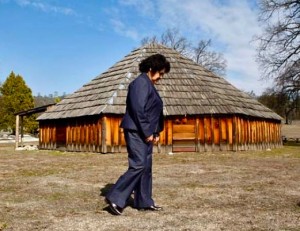Note: This novel is WINNER of the National Book Award for Fiction, 2012.
“Your people were brought together by us buffalo once. You knew how to hunt and use us. …[You had] rules that respected us and forced you to work together. Now we are gone, but…the round house will be my body, the poles my ribs, the fire my heart. It will be the body of your mother and it must be respected the same way.” –Old Female Buffalo, speaking to Nanapush, who then instructed his people how to build the round house.
 Author Louise Erdrich, a member of the Turtle Mountain band of Chippewa (Ojibwa) Native Americans, here writes one of her most powerful and emotionally involving novels. Though it starts as a crime story on the reservation, it quickly becomes an intense search for justice on all levels. As in Erdrich’s other novels, it also develops into an examination of the lives of her characters, both old and young, as they face the challenges of reservation life. Their lives, as she shows in this novel, are seriously restricted by 1988, when this novel’s action takes place, far more restricted than they were even two generations ago, and totally different from life at the turn of the 20th century when the Chippewa still controlled wide swathes of the northern boundary of the United States and Canada. The buffalo on which they once depended for sustenance have become extinct in the wild, and the federal government of the United States has systematically appropriated nearly all the lands which the Chippewa and their ancestors once controlled and roamed at will.
Author Louise Erdrich, a member of the Turtle Mountain band of Chippewa (Ojibwa) Native Americans, here writes one of her most powerful and emotionally involving novels. Though it starts as a crime story on the reservation, it quickly becomes an intense search for justice on all levels. As in Erdrich’s other novels, it also develops into an examination of the lives of her characters, both old and young, as they face the challenges of reservation life. Their lives, as she shows in this novel, are seriously restricted by 1988, when this novel’s action takes place, far more restricted than they were even two generations ago, and totally different from life at the turn of the 20th century when the Chippewa still controlled wide swathes of the northern boundary of the United States and Canada. The buffalo on which they once depended for sustenance have become extinct in the wild, and the federal government of the United States has systematically appropriated nearly all the lands which the Chippewa and their ancestors once controlled and roamed at will.
 Native Americans who want to honor the “old ways” on the reservation must now survive on infertile lands which cannot support them. Their culture has been seriously compromised by the arrival of dedicated Catholic priests who have weaned them away from the myths and traditions which have always provided a cultural center, sense of meaning, and shared heritage among them. Legal jurisdiction over crimes involving Native Americans is also an issue, since tribal officials, state police, and even the FBI all have interests in areas in which crimes are perpetrated by whites against Native Americans and vice versa. The cultural bases for many “laws” held as inviolable by each group are not always compatible, and many on the reservation, discouraged, are unable to find much reason to hope for improvement in the future, often finding solace in television, drugs, sex, and alcohol.
Native Americans who want to honor the “old ways” on the reservation must now survive on infertile lands which cannot support them. Their culture has been seriously compromised by the arrival of dedicated Catholic priests who have weaned them away from the myths and traditions which have always provided a cultural center, sense of meaning, and shared heritage among them. Legal jurisdiction over crimes involving Native Americans is also an issue, since tribal officials, state police, and even the FBI all have interests in areas in which crimes are perpetrated by whites against Native Americans and vice versa. The cultural bases for many “laws” held as inviolable by each group are not always compatible, and many on the reservation, discouraged, are unable to find much reason to hope for improvement in the future, often finding solace in television, drugs, sex, and alcohol.

Typical Round House
In a powerful opening scene, filled with symbols and portents, thirteen-year-old Antone Basil Coutts (Joe), only child and namesake of Judge Coutts and his wife Geraldine, is helping his father to pull tiny seedlings from cracks in the foundation of their house. They are awaiting Geraldine’s return from the office, where she works recording the genealogies of the members of their band of Chippewa, keeping track of marriages, births, who is living there, and who has moved away. When she finally arrives at home, she is almost unrecognizable, so badly beaten she can hardly see, reeking of gasoline and so traumatized by rape and other crimes against her that she has become mute. She claims not to know who has committed this crime or where it took place, hiding out in her room after she is released from the hospital and refusing to leave. The boy, known as Joe to his friends and “Oops” to some of his relatives, knows that it will be up to him and his father to try to find out who has done this. They begin to study cases in which his father has been involved to look for clues.

The RedCliff Band from Lake Superior shows some of the same sacred images as are prominent in this novel
In the meantime, Joe and his friends begin to look around on their own, and they discover where the crime may have taken place. Eventually, he and his father realize that the crime was almost certainly committed by a white man. The perpetrator has a long history of crimes, but he has never been convicted of them. As they investigate further, they discover that the crime against Geraldine is even bigger than they had imagined, involving two other innocent females, now missing.
Joe, despite his drive to catch the criminal, is still a child, and his empathetic father wants to protect him as much as possible. Joe, however, is obsessed with getting his mother “back,” determined to find and punish the rapist on his own. These tensions add drama and meaning to the novel, and Joe’s contacts with others, both in his family and outside it, expand the scope. The sweat lodge ceremony is described, the extortion of elderly Indians by a white-owned supermarket on Indian land is detailed, the raucous and sexy (and hilarious) talk of elderly family members is recorded, the “flirting” of a stripper living with Joe’s uncle is tension-filled and emotional, the appearance of ghosts to Joe, and the efforts of a local priest, a former soldier who was injured in Lebanon in 1983 in the attack on the U.S. Embassy, are all described to powerful effect, keeping the interest and involvement of the reader at high pitch.

Young powwow dancer participates in the Honor the Earth ceremony of 2009.
Joe’s own search for peace eventually takes him to the lake and an almost magical episode with a heron, one of the sacred animals to him, while the story of Nanapush and Mooshum and the Old Buffalo Woman, telling them to build the round house, add character and depth to the narrative. Many side stories, some of them very funny, fill in the thematic elements, and the conclusion is unforgettable, complex and loving, however filled with terror. Erdrich, wisely, never lets her reader forget that Joe and his friends are very young teenagers, their mistakes, some of them serious, those of naivete, innocence, and the belief that justice just HAS to prevail if the world is going to be a place they want to inhabit.

Ojibwe children participate in traditional ceremonial dress.
Erdrich has always provided a sense of continuity among her fourteen novels by connecting many characters in successive plots. Here she includes episodes from the life of the priestly Nanapush (from Tracks), who was an inspiration to Mooshum, thought now to be one hundred six years old in this novel. Mooshum, whose story is told here, was also a main character in The Plague of Doves, a book which also includes Judge Antone Basil Coutts, father of this novel’s main character Joe, and Corwin Peace, father of Joe’s friend Zach. By repeating these characters through successive generations, Erdrich provides a kind of genealogy and sense of history which add to the sense of time and place, and highlight the changes, not all of them good, taking place within the community. The novel, one of Erdrich’s best, will keep serious readers totally engaged, even as those interested in just a “good story” will celebrate the action, excitement, and important issues it raises.
ALSO by Erdrich: THE PAINTED DRUM, SHADOW TAG, LAROSE, THE SENTENCE
Photos, in order: The author’s photo by Paul Emmell appears on http://www.tpt.org
The photo of the round house by Deanne Fitzmaurice is from a different Indian group from that of this novel, but the description of its hexagonal structure is compatible with the description in The Round House. http://www.sfgate.com
The action of this novel takes place in North Dakota, not Wisconsin, where the Red Cliff Band lives, but I’ve included it here because the heron, the dolphin, and the eagle, pictured here, also have symbolic significance to Joe and his band in N Dakota. http://redcliff-nsn.gov
The young pow wow dancer (by Amy Puzia) is participating in the Honor the Earth Pow Wow from 2009:
http://www.fotopedia.com
The Ojibwe (Chippewa) children participating in a pow wow are wearing their traditional costumes.
http://redcliff-nsn.gov
